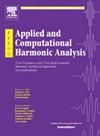用物理信息卷积神经网络求解球面上的 PDEs
IF 3.2
2区 数学
Q1 MATHEMATICS, APPLIED
引用次数: 0
摘要
物理信息神经网络(PINN)已被证明能从多种实验角度高效地求解偏微分方程(PDE)。最近的一些研究还提出了针对包括球体在内的曲面上的偏微分方程的 PINN 算法。然而,对于 PINN 的数值性能,尤其是曲面或流形上的 PINN,仍然缺乏理论上的了解。在本文中,我们建立了用于求解球面上 PDE 的物理信息卷积神经网络(PICNN)的严格分析。通过使用并改进深度卷积神经网络和球面谐波分析的最新近似结果,我们证明了关于索博列夫规范的近似误差上限。随后,我们将其与创新的定位复杂性分析相结合,建立了 PICNN 的快速收敛率。我们的理论结果也得到了实验的证实和补充。鉴于这些发现,我们探讨了规避高维 PDEs 求解时出现的维度诅咒的潜在策略。本文章由计算机程序翻译,如有差异,请以英文原文为准。
Solving PDEs on spheres with physics-informed convolutional neural networks
Physics-informed neural networks (PINNs) have been demonstrated to be efficient in solving partial differential equations (PDEs) from a variety of experimental perspectives. Some recent studies have also proposed PINN algorithms for PDEs on surfaces, including spheres. However, theoretical understanding of the numerical performance of PINNs, especially PINNs on surfaces or manifolds, is still lacking. In this paper, we establish rigorous analysis of the physics-informed convolutional neural network (PICNN) for solving PDEs on the sphere. By using and improving the latest approximation results of deep convolutional neural networks and spherical harmonic analysis, we prove an upper bound for the approximation error with respect to the Sobolev norm. Subsequently, we integrate this with innovative localization complexity analysis to establish fast convergence rates for PICNN. Our theoretical results are also confirmed and supplemented by our experiments. In light of these findings, we explore potential strategies for circumventing the curse of dimensionality that arises when solving high-dimensional PDEs.
求助全文
通过发布文献求助,成功后即可免费获取论文全文。
去求助
来源期刊

Applied and Computational Harmonic Analysis
物理-物理:数学物理
CiteScore
5.40
自引率
4.00%
发文量
67
审稿时长
22.9 weeks
期刊介绍:
Applied and Computational Harmonic Analysis (ACHA) is an interdisciplinary journal that publishes high-quality papers in all areas of mathematical sciences related to the applied and computational aspects of harmonic analysis, with special emphasis on innovative theoretical development, methods, and algorithms, for information processing, manipulation, understanding, and so forth. The objectives of the journal are to chronicle the important publications in the rapidly growing field of data representation and analysis, to stimulate research in relevant interdisciplinary areas, and to provide a common link among mathematical, physical, and life scientists, as well as engineers.
 求助内容:
求助内容: 应助结果提醒方式:
应助结果提醒方式:


